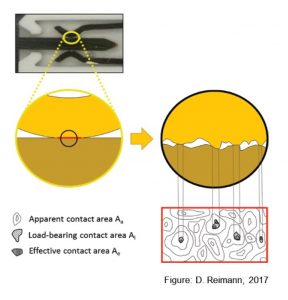 Contact plating material options for electronic connectors: Part 2
Contact plating material options for electronic connectors: Part 2
January 11, 2019 REDWIRE is news you can use from leading suppliers. Powered by FRASERS.
Posted by Harting Canada Inc
The family-owned HARTING Group is a global leader in connectivity solutions. HARTING invented the modular connector and... Read more
Subscribe
Free REDWIRE e-newsletter

Schematic view of an electrical interface
In this six-part article, the HARTING Technology Group discusses plug-in connectors and options available for contact plating. This part deals with the contact system and contact resistance. Click here to read Part 1.
The contact system
The contact system consists of a male and a female contact with a spring element. Male contacts are normally made of brass because of its mechanical strength and no need for mechanical flexibility. Female contacts are normally made of bronze with greater spring properties and, therefore, a lower relaxation behaviour, which ensures a stable contact normal force of the spring element during the complete lifetime of the connector system.
The contact resistance
The total resistance of the connection system (Rtotal) consists of the contact resistance (Rcontact zone) as well as the resistance of the bulk material (Rbulk) and the termination area (Rtermination) of both contact partners (male + female).
The area, at which macroscopically a contact occurs, is called “apparent contact area” (Aa). All solid surfaces are rough on the microscale, meaning that the surface consists of peaks and troughs. Thus a contact between two contact surfaces occurs only at discrete areas, the so-called “load bearing contact area” (Al), produced by the mechanical contact of so-called “asperities” on the two surfaces. For low contact forces, this is just a small fraction of the apparent contact area. Due to impurities or contaminations, like oxides, the “effective contact area” (Ae), where the current is transmitted from one surface to another, is even smaller. This effective contact area is like a collection of small spots, the so-called “a-spots”.
Although the resistance makes only a small percentage of the total resistance of the circuit, it is one of the most important characteristics of an electrical contact. Strong fluctuations or strong increases can lead to malfunctions or even to the failure of a system. The resistance of the contact zone is made up of the so-called “constriction resistance” (Rc) and the “film resistance” (Rf) caused by contaminations like oxides on the contact surface.
The constriction resistance of closed connectors is caused by the constriction of the current lines in the area of the effective contact area. Due to mechanical deformation, the number and the area of a-spots and, therefore, the effective contact area increases with increasing contact normal force. As a result, the constriction resistance decreases with increasing contact force. Higher normal forces also lead to lower film resistance due to fracturing of oxide films, resulting in an increase of the effective contact area.
Coming up in Part 3: Contact surfaces
For more information, contact HARTING.
Share
Posted by Harting Canada Inc
The family-owned HARTING Group is a global leader in connectivity solutions. HARTING invented the modular connector and... Read more